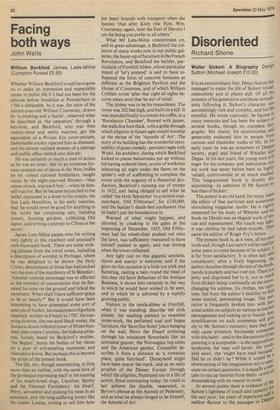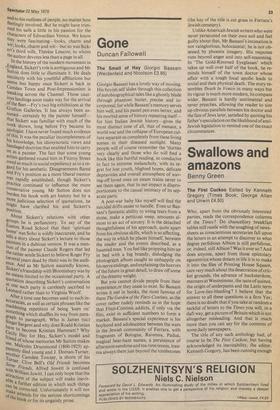Disoriented
Richard Shone
Walter Sickert: A Biography DenYs Sutton (Michael Joseph £10.50)
It is an extraordinary feat. Denys Sutton has managed to make the life of Sickert trivial. melancholy and in places dull. Of all the painters of his generation and those immedl" ately following it, Sickert's character was astonishingly rich and complex, and his life eventful. He wrote copiously, he figures In many memoirs and has been the subject.of several books, though no complete biography. His charm, his eccentricities and generosity endeared him to people front curious and dissimilar walks of life. in his early years he was an ornament of DiepPe society, pupil and friend of Whistler and Degas. In his last years, the young were still eager for his company and instruction and his work has never before been so highlY valued, controversial or so much studied. This long-awaited book is doubly disappointing—to admirers of Mr Sutton no less than of Sickert.
The author is an old hand, for many Years the editor of that patrician and sometirnes stimulating magazine Apollo. He is rightly respected for his study of Whistler and his book on Derain was an elegant work of Nscue and reassessment. His touch was light' it was obvious he had taken trouble. Then came his edition of Roger Fry's letters. The present book is, as it were, all his owa work and, though I am sure it will be read far some years to come because of its subject, is far from satisfactory. It is often lazy alla complacent ; after a lively beginning, the author slouches through the rest of the book, hands in pockets and hat over eye. There 63 jerky and disjointed feel to it, not so much from Sickert being continually on the m0v.e' changing his address, his clothes, his ions, but from the author's inability to fin° some central, permeating image. The flat': rative is frequently broken into with per, sonal asides on subjects as various as marital estrangement and waking up in Venice. A.flYe amplification on such comments will givn zip to Mr Sutton's memoirs; here they °ad only cause irritation. Intimately connect!,, with this habit—and in the discussions of. tn: painting it is acceptable—is the suppositlob°, syndrome, the 'may well haves', the pro, ably saws', the 'might have read becatise Did he or didn't he ? While it would be shortcoming of the imagination not to sPecs, ulate on certain questions, it is equally a fill f. take to run up theories from them—a sort Of with no wearer in mind. km. At several points there is evidence of Sutton's lightness of touch and capacitY for the mot juste; his years of experience add ae mellow flavour to the passages in piePP and to his outlines of people, no matter how fleetingly involved. But he might have trimmed his sails a little in his passion for the characters of Edwardian Venice. We know they were fascinating—looks, charm and Wit; looks, charm and wit—but so was Sickert's third wife, Therese Lessore, to whom the author devotes less than a page in all. In the history of the modern movement in Pnglan Sickert's role is ambiguous and Mr Sutton does little to illuminate it. He deals succinctly with his youthful affiliations but seems less happy once Sickert is back in Camden Town and Post-Impressionism is sneaking across the Channel. Those cautle'lls landings soon make way for the arrival of the fleet—Fry's two big exhibitions at the Grafton Galleries. It has always been assumed—certainly by the painter himself— that Sickert was familiar with much of the Work shown, long before Fry became its apologist. I have never found much evidence of this. It was the peculiar incompleteness of his knowledge, his idiosyncratic views and bandaged doctrine that enabled him to carry On as a painter. The fact that some young artists gathered round him in Fitzroy Street owed as much to social expediency as to a regard for his aesthetic. Disagreements flared and Fry's position as a more liberal mentor was rapidly established, though Sickert's Practice continued to influence the more conservative young. Mr Sutton does not burden his book with art history but by a more judicious selection of quotations, he might have clarified his and Sickert's Position.
About Sickert's relations with other groups he is perfunctory. To say of the Euston Road School that their `spiritual borne' was Soho is wildly inaccurate, and he tells a story about Sickert's lecture to those Painters in a dubious version. It was a mention of the painter Claude Rogers that led the rather senile Sickert to believe Roger Fry (several years dead by then) was in the audience. And as Mr Sutton assuredly knows, Sickert's friendship with Bloomsbury was by n° means limited to the occasional party. A quotation describing Sickert's conversation tt °fle such party is carelessly ascribed to 1-eonard rather than to Virginia Woolf. After a time one becomes used to such inaccuracies, as well as certain phrases like the Maddening repetition of being 'keen on' scunething which shuffles its way from pararnPh to paragraph. Who is James (sic) litger Sargent and why does Roald Kristian cave to become Kristian Hammett ? Why frecIlY Hay for Hey, Sickert's model and iend
of whose memories Mr Sutton makes use. Malcolm Drummond (1860-1925) ap
13_ arentlY died young and J. Doman-Turner, a_rnOther Camden Towner, is shorn of his surlier. Clive Bell's Old Friends becomes w?Ine Friends, Alfred Jowett is confused atitth William Jowitt. I can only hope that the ablractinn of the subject will make inevite,a further edition in which such things
rnankoe corrected. Unfortunately it will not
of ti_e amends for the serious shortcomings 'le book or for its ungainly prose.



































 Previous page
Previous page